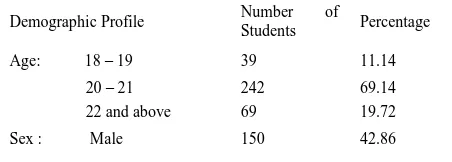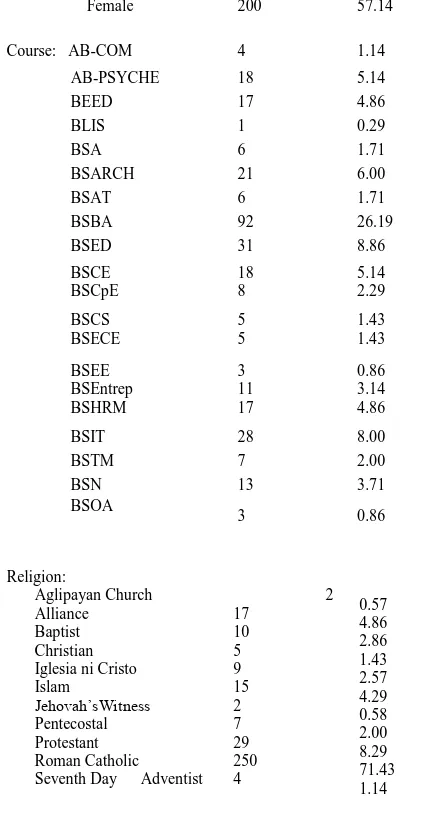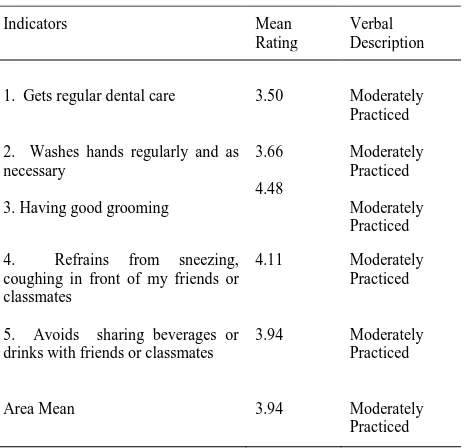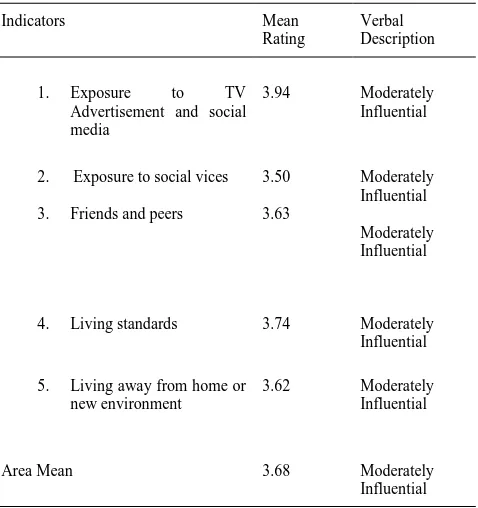Health Practices Among College Students Of Notre
Dame Of Dadiangas University
Claire Tudayan-Espiritu, Rue Flora P. Ruiz
RN, MAN, MIC, Notre Dame of Dadiangas University College of Health Sciences General Santos City, Philippines (+63)
clairetudayan@yahoo.com
Ph.D., RN,Notre Dame of Dadiangas University College of Health Sciences General Santos City, Philippines (+63)
Abstract: This study determined the extent of health practices of college students on the aspects of dietary, exercise, hygiene and lifestyle, and the extent of influences on the factors contributing to their health practices in terms of physiological, psychological, social and emotional. Two designs were utilized in this study. One was descriptive research design with a qualitative supplementation of data which was used to describe the health practices of college students along with the intent of exploring the influences of the factors affecting health practices. The other one was the developmental design which was used as basis for the development of a proposed health program. Results of the study revealed that the extent of health practices in terms of hygiene was Moderately Practiced as shown by the area mean of 3.94. Similarly, the extent of health practices, in terms of lifestyle was Moderately Practiced as revealed by an area mean of 3.92. In terms of dietary and exercise, the extent of health practices was Fairly Practiced as disclosed by an area mean of 3.48 and 3.14 respectively. Furthermore, of the factors affecting health practices was Moderately Influential as evidenced by mean scores of 3.90 for physiological, 3.82 for psychological, 3.81 for emotional and 3.68 social. Based on the results of the study, the researchers concluded that majority of the college students exhibited healthy habits in both hygiene and lifestyle. However, they showed some unhealthy eating behaviors like consuming high intake of added sugars and soft drinks and not eating a well- balanced diet. They also demonstrated decreased physical activity and more sedentary activities. Moreover, physiological, psychological, social and emotional factors contribute greatly to their health practices.
Keywords: Health practices of college students; Dietary and exercise practices; Lifestyle and hygiene practices
1.
Introduction
College students have a higher risk of making unhealthy lifestyle choices that could influence their health and wellbeing. This may be associated to their newfound freedom from direct parental guidance and typical peer pressure they face during young adult years [1]. This is also linked with changes and new responsibilities like greater control over their health and exploration of choices. However, this also presents a stressful experience as these young adults need to adapt to changes in their life. These changes may include increased academic workloads, new environments and financial and social pressures [2]. Statistics from the World Health Organization (WHO) (2017) indicated that of the 56.4 million deaths worldwide in 2015, more than half (54%) were due to the top 10 causes. These are ischemic heart disease and stroke, lower respiratory infection, chronic pulmonary disease, lung cancer, diabetes, diarrheal diseases, alzheimer‟s disease, tuberculosis and road injury [4]. All of these can be closely linked to health- related behaviors which can be prevented through good health practices. According to [3] there is evidence that many students engage in various unhealthy and risky health practices, and other negative practices, which may produce long-term adverse effects on their health. It further indicates that poor health practices such as alcohol and tobacco use, physical inactivity and unhealthy dietary practices may lead to non communicable diseases (NCDs) such as cardiovascular diseases, cancers, respiratory diseases, diabetes and other NCDs which account for 28% of all fatalities [4]. Conversely, other risk includes ignoring hand hygiene which is a contributive factor to infectious diseases. The high probability of having these diseases can be related to other factors such as stress, nutrition, environment or weak immune system. College students may
be aware of the importance of good health practices but are not consciously practicing them. Moreover, the school clinic and guidance center of the University do not have programs which are centered on the health practices of college students. In addition, college students were surveyed about their satisfaction of the school canteen during the school year 2016-2017. The survey dealt on the quality and quantity of food for meals and snacks as well as the kind of drinks and beverages including its nutritional value. Data revealed a mean rate of 3.29 which means average satisfaction. As the health practices of these students are influenced by many factors, there is a need to educate them on the implications of their practices, which might later influence their health behavior. Good health practices that students make early in their life influence their subsequent health status [1]. The above mentioned practices and unhealthy lifestyle causing diseases are related to behavior. This means that these are preventable if identified and changed at an early stage. It is in this light that this study was conducted, that is, to investigate the various health practices of college students and to propose an intervention program based on its findings. Furthermore, data from the results of the study would be used to promote healthy lifestyle in the school campus.
1.1. Objectives of the Study
2.
Method
2.1 Research Design
This study employed quantitative descriptive research design with qualitative supplementation of data and developmental research design. On the one hand, descriptive design was used to describe the extent and factors affecting the health practices of college students. The qualitative techniques explored the contributing factors affecting health practices for college students. The reason for collecting both quantitative and qualitative data was to give a wider understanding of the data at a more detailed level by incorporating qualitative follow-up data to help explain a quantitative database. On the other hand, developmental design was used for the development of a proposed health program.
2.2 Locale of the Study
This study was conducted at the Notre Dame of Dadiangas University, a Catholic school founded by the Marist Brothers in 1953. The school lies at the Southern Mindanao area specifically located in Marist Avenue, General Santos City. In the second semester of the school year 2017-2018, it has a total population of 2,864. The university offers undergraduate courses which include business, engineering, information technology, arts, education and health.
2.3 Respondents of the Study
The respondents of the study were the college students from the different departments of the university. There were 2,864 college students enrolled in the second semester. To determine the total number of respondents, the researchers used the Slovin‟s formula. A number of 350 college students were identified as the respondents of the study.
2.4 Research Instrument
This study used a researcher-formulated questionnaire. The questionnaire had three parts. Part I asked for data on the profile of the college students. Part II gathered data on the extent of health practices. Part III solicited data on the extent of influences on the factors contributing to health practices. A semi-structured questionnaire was also utilized in the focus group discussion. This was to explore the factors affecting health practices. The semi-structured questionnaire was composed of open-ended questions which allowed the participants to provide their views freely. The questionnaires used in the study underwent content and face validity. These were validated by three (3) experts, two (2) clinical instructors and one (1) English expert. The result of the validation showed the overall weighted mean of 4.23, interpreted as highly appropriate.
2.5 Sampling Technique
This study used a specific type of non-probability sampling method known as convenience sampling. Data on health practices was taken from college students who were readily available at the specified time of the data gathering period.
2.6 Research Procedure
A letter asking permission from the President of the University through the Vice-President for Academics was obtained. After the approval, a letter of invitation was sent to the respondents. Those who responded positively to the invitation were asked to sign a consent signifying their
willingness to be part of the study. A validated questionnaire was distributed to the identified respondents. Data obtained from the health practices of college students were treated statistically. Furthermore, the researchers conducted a focus group interview to eight participants. This interview used a semi-structured and generally open-ended question to elicit the participants‟ views and opinions about the contributing factors affecting health practices. Informed consent was sought from the participants prior to the conduct of the study. The participants were informed of the purpose of the study, the benefits, risks, and their voluntary participation as well as their right to withdraw. Before the focus group, all participants were asked to answer the questionnaire that includes profile, extent of health practices and contributing factors affecting health practices. After the completion of the questionnaire, focus group was facilitated by the researchers themselves. One researcher facilitated the focus group while the other researcher took notes during the discussions. To make sure not to overlook any comment from the participants, the researcher audio taped the group discussion. The respondents were informed about this through the informed consent form. The sets of information collected were treated confidentially through the use of codes to get rid of identifiers which may reveal the participants‟ information. Responses from the interviews used codes instead of respondents‟ names. The interview ran for thirty minutes to one hour.
2.7 Statistical Tool
The quantitative data gathered in the study were organized, collated, tallied and tabulated. Frequency and percentage were utilized in treating the profile of the respondents. Weighted mean was used to analyze the data on the health practices as well as the factors affecting health practices of the college students. The qualitative data extracted from focus group discussion was used as supplemental data or support data to the results gathered quantitatively.
3.
Results
3.1 Profile of College Students
The demographic profile of college students in terms of age at the time of survey, gender, course taken and religion is presented in Table 1. Findings showed that 242 (69.14%) of the respondents were aged 20-21; 39 (11.14%) were aged 18-19; and 69 (19.72%) were aged 22 and above. In terms of gender, results revealed that 200 (57.14%) of the respondents were female and 150 (42.86%) were males. Results on the courses taken by the respondents revealed that Bachelor of Science in Business Administration (BSBA) was considered the topmost chosen course as 92 (26.19%) of the respondents enrolled in it. In terms of religion, results demonstrated that 250 (71.43%) of the respondents were Roman Catholic (RC), and only 2 (0.57%) of the respondents were Aglipayan.
Table 1.Demographic Profile of College Students (n = 350)
Demographic Profile Number of
Students Percentage
Age: 18 – 19 39 11.14
20 – 21 242 69.14 22 and above 69 19.72
Female 200 57.14
Course: AB-COM 4 1.14
AB-PSYCHE 18 5.14
BEED 17 4.86
BLIS 1 0.29
BSA 6 1.71
BSARCH 21 6.00
BSAT 6 1.71
BSBA 92 26.19
BSED 31 8.86
BSCE BSCpE
18 8
5.14 2.29 BSCS
BSECE
5 5
1.43 1.43
BSEE BSEntrep BSHRM
3 11 17
0.86 3.14 4.86
BSIT 28 8.00
BSTM 7 2.00
BSN 13 3.71
BSOA 3 0.86
Religion:
Aglipayan Church
Alliance Baptist
Christian Iglesia ni Cristo Islam
Jehovah‟sWitness Pentecostal Protestant Roman Catholic
Seventh Day Adventist
2
17 10 5 9 15 2 7 29 250 4
0.57 4.86 2.86 1.43 2.57 4.29 0.58 2.00 8.29 71.43 1.14
3.2. Extent of Health Practices in Dietary
The extent of health practices of college students in terms of dietary or eating habits is presented in Table 2. Information on the table revealed that a larger number of respondents took their meal regularly or consumed their meal three times a day as evidenced by the mean rating of 3.95 (moderately practiced) and ate freshly home cooked food rather than fast food as shown by the mean of 3.89 (moderately practiced). However, findings revealed that the respondents fairly practiced limiting the amount of added sugar and salt as disclosed by the mean of 3.34.
Table 2. Extent of Health Practices in terms of Dietary (n = 350)
Indicators Mean Rating Verbal
Description
1. Eats home cooked food rather than fast food
3.89 Moderately Practiced
2. Takes my meals regularly
3. Limits the amount of added sugar and salt
3.95
3.34
Moderately Practiced
Fairly Practiced
4. Uses information about nutrition in food choices
2.95 Fairly Practiced
5. Follows a healthy eating pattern like consuming vegetables, fruits, meat, grains and dairy foods
3.28 Fairly Practiced
Area Mean 3.48 Fairly Practiced
3.3 Extent of Health Practices in Exercise
The extent of health practices of college students in terms of Exercise is shown in Table 3. Results revealed that respondents fairly practiced exercise. The most-liked activity was walking around or taking the stairs instead of using elevator or escalator as evidenced by the high mean rating of 3.47 (Fairly Practiced). The least-liked activity was muscle strengthening like push-ups, sit-ups, lifting weights, and heavy gardening as indicated by the lowest mean rating of 2.81 (Fairly Practiced).
Table 3.Extent of Health Practices in terms of Exercise (n = 350)
Indicators Mean Rating Verbal
Description
1. Does muscle strengthening activities like push-ups, sit-ups, lifting weights, heavy gardening every week
2.81 Fairly Practiced
2. Does moderate activities like brisk walking or cycling every week
3. Walks around or takes the stairs instead of using elevator or escalator.
3.00
3.47
Fairly Practiced
Fairly Practiced
4. Reduces time spend in sitting watching TV, and playing computer games
3.31 Fairly Practiced
5. Plays recreational sports (tennis, volleyball, etc.) outside or join intramural activities in the school
3.11 Fairly Practiced
Area Mean 3.14 Fairly Practiced
3.4. Extent of Health Practices in Hygiene
Table 4. Extent of Health Practices in terms of Hygiene (n =
350)
Indicators Mean
Rating
Verbal Description
1. Gets regular dental care 3.50 Moderately Practiced
2. Washes hands regularly and as necessary
3. Having good grooming
3.66
4.48
Moderately Practiced
Moderately Practiced
4. Refrains from sneezing, coughing in front of my friends or classmates
4.11 Moderately Practiced
5. Avoids sharing beverages or drinks with friends or classmates
3.94 Moderately Practiced
Area Mean 3.94 Moderately
Practiced
3.5 Extent of Health Practices in Lifestyle
The extent of health practices in terms of Lifestyle is shown in Table 5. Information on the table showed that the respondents moderately practiced the following: avoiding the use of drugs which gained the highest mean score of 4.04; staying away from cigarettes and other tobacco products and avoiding premarital sex or engaging into high risk sexual behavior which both obtained a mean score of 3.95; reducing intake of caffeinated beverages like coffee, tea, etc, which got a mean rating of 3.93; and avoiding alcoholic beverages which got a mean score of 3.75.
Table 5.Extent of Health Practices in terms of Lifestyle (n = 350)
Indicators Mean
Rating
Verbal Description
1. Stays away from cigarettes and other tobacco products
3.95 Moderately Practiced
2. Avoids alcoholic beverages
3. Avoids drugs
3.75
4.04
Moderately Practiced
Moderately Practiced
4. Reduces intake of caffeinated beverages like coffee, tea, etc.
3.93 Moderately Practiced
5. Avoids premarital sex or engage into high risk sexual behavior.
3.95 Moderately Practiced
Area Mean 3.92 Moderately
Practiced
3.6 Extent of Influences of Physiological Factors
Table 6 presents the extent of influences of physiological factors contributing to current health practices. Results revealed that sleeping pattern obtained a mean score of 4.00,
interpreted as Moderately Influential while chronic and acute diseases had a mean score of 3.70, described as Moderately Influential. The rest of the physiological factors were all interpreted Moderately Influential.
Table 6. Extent of Influences of Physiological Factors Contributing to Current Health Practices (n = 350)
Indicators Mean Rating Verbal
Description
1. Sleeping pattern 4.00 Moderately
Influential
2. Chronic and acute diseases
3. Hygiene
3.70
3.88
Moderately Influential
Moderately Influential
4. Food Choices 3.94 Moderately
Influential
5. Physical activity 3.98 Moderately
Influential
Area Mean 3.90 Moderately
Influential
3.7 Extent of Influences of Psychological Factors
The extent of influences of psychological factors contributing to current health practices is shown in Table 7. Data revealed that socioeconomic status garnered the highest mean rating of 3.89, and both coping strategies and resilience obtained a mean rating of 3.79. All the indicators were all interpreted as Moderately Influential implying that these factors often affect their current health practices.
Table 7. Extent of Influences of Psychological Factors Contributing to Current Health Practices (n = 350)
Indicators Mean Rating Verbal
Description
1. Religious Beliefs 3.81 Moderately
Influential
2. Coping strategies
3. Family support and networks
3.79
3.83
Moderately Influential
Moderately Influential
4. Socioeconomic status 3.89 Moderately Influential
5. Resilience or overcoming difficulties
3.79 Moderately Influential
Area Mean 3.82 Moderately
Influential
3.8. Extent of Influences of Social Factors
score of 3.94, whereas exposure to social vices was rated as
the lowermost influential factor with a mean score of 3.50.
Table 8. Extent of Influences of Social Factors Contributing to Current Health Practices (n = 350)
Indicators Mean
Rating
Verbal Description
1. Exposure to TV
Advertisement and social media
3.94 Moderately Influential
2. Exposure to social vices
3. Friends and peers
3.50
3.63
Moderately Influential
Moderately Influential
4. Living standards 3.74 Moderately
Influential
5. Living away from home or new environment
3.62 Moderately Influential
Area Mean 3.68 Moderately
Influential
3.9 Extent of Influences of Emotional Factors
The extent of influences of emotional factors contributing to current health practices is shown in Table 9. As seen in the table, perception of stress acquired a mean of 3.95, rated as the most influential factor and interpreted as Moderately Influential. Peer pressure obtained only 3.45, rated as the least influential factor and interpreted as Fairly Influential. The rest of the emotional factors were all interpreted Moderately Influential.
Table 9. Extent of Influences of Emotional Factors Contributing to Current Health Practices (n = 350)
Indicators Mean
Rating
Verbal Description
1. Peer pressure 3.45 Fairly Influential
2. Perception of stress
3. Sense of control
3.95
3.87
Moderately Influential
Moderately Influential
4. Self esteem 3.84 Moderately
Influential
5. Pressure of work or Workload
3.94 Moderately Influential
Area Mean 3.81 Moderately
Influential
3.10 Ranking of Factors
Ranking of factors according to the influence of the current health practices is shown in Table 10. Data revealed that physiological factors rank first as evidenced by the area mean of 3.90, followed by psychological factors which acquired the mean score of 3.82. Emotional factors and social factors obtained an area mean of 3.81 and 3.68 respectively.
Table 11.Ranking of Factors According to the Influence of the Current Health Practices
Contributing Factor Indicators Weighted Mean
Rank
1. Physiological 3.90 1
2. Psychological 3.82 2
3. Emotional 3.81 3
4. Social 3.68 4
3.11 Proposed Wellness Program
The development of this proposed wellness program was based on the results of the study. The findings of the study revealed that health practices in both dietary and exercise obtained an area mean of 3.48 and 3.14 respectively. Since these were both interpreted as Fairly Practiced, an intervention program needs to be designed to promote healthy eating behaviors and enhance exercise practices. The proposed wellness program is a school- based intervention program created to improve the health of college students of Notre Dame of Dadiangas University (NDDU) through the promotion of healthy lifestyle. It also offers help to students in making positive choices specific to their needs. It has two main components, the dietary intervention program and exercise intervention program.
4.
Conclusion and Recommendation
4.1 Conclusion
Based on the results of the study, the researchers concluded that majority of college students exhibited healthy habits in both hygiene and lifestyle as shown by the data gathered on their health practices. However, college students showed some unhealthy eating behaviors like consuming high intake of added sugars and soft drinks and not eating a well-balanced diet. They also demonstrated decreased physical activity and more sedentary activities. Moreover, physiological, psychological, social and emotional factors contribute greatly to their health practices.
4.1 Recommendation
The study recommended the following:
1. That the proposed wellness program has to be adopted and implemented in the existing school programs;
2. That proposed wellness program has to be included in the orientation seminar (ORSEM) of first year students and during PTCA, in collaboration with the Guidance and Testing Center;
sweetened beverages are eliminated or accessed limitedly
by students;
4. That the food products sold in the canteen have to be monitored and checked;
5. That the school clinic has to provide guidance on health and if necessary referrals for students with nutritional problems;
6. That awareness on the importance of exercise or regular physical activities among college students has to be promoted through seminars;
7. That nutrition education school program has to be promoted through symposium to help students adopt healthy eating behaviors;
8. That further researches have to be conducted to explore the factors that influence health practices and their implications.
References
[1] E. Niekerk and J. Barnard “Health and Lifestyle Practices among Female Students in a South African University Setting” 2011.Academic Journal Article and College Student Journal
[2] Janse van Rensburg, C. & Surujlal, J., 2013, „Gender differences related to the health and lifestyle patterns of university students‟, Health SA Gesondheid 18(1), Art. #735, 8 pages. http:// dx.doi.org/10.4102/hsag. v18i1.735
[3] G. Edlin and E. Golanty “Health and Wellness”. 11th ed.Burlington, MA: Jones & Bartlett Learning; 2014.
[4] World Health Organization (WHO) “Top 10 Causes of Death” 2017 Factsheets
Author Profile
Author 1 Profile
The author 1 is a Registered Nurse and a faculty member of Notre Dame of Dadiangas University under the College of Health Sciences. She holds a Master of Arts in Nursing degree from Notre Dame of Dadiangas University, General Santos City and a Master in Chemistry degree at Notre Dame of Marbel University, City of Koronadal, South Cotabato.
Author 2 Profile



